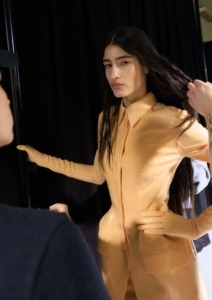Oil treatments transformed my hair - but only once I followed one rule
by Kristina Mikulić GazdovićNovember 13, 2025


November 13, 2025
There’s one evening ritual I never skip. When everything quiets down, I take a few drops of cold-pressed almond oil, massage it into the lengths of my hair, braid it, and let this nourishing oil work its magic overnight. The scent, the shine, the way it feels between my fingers — everything about it carries a soothing energy. My hair loves it. My scalp? Not so much.
For years, I followed the advice to “nourish your hair from roots to ends.” And yes, it sounds logical — until you realize your roots might not agree. These days, I apply the oil only to the lengths of my hair, from midsection to the ends. Every other evening, I repeat this ritual: I gently massage my favorite almond oil in, carefully comb it through (no tugging or harsh movements), and braid my hair.
In the morning, I wake up to transformed hair — softer, smoother, and shinier. After a year of this small ritual, I’ve noticed my fine hair has become stronger and more resilient. But the roots? They stay untouched, and for a very good reason.

Courtesy of Adanola
Our scalp isn’t a barren surface from which hair simply grows. It’s a living micro-world full of microorganisms that protect the skin barrier’s balance. One of them, a tiny fungus called Malassezia, feeds on natural sebum and oils. When we give it too much “food” (read: apply oil directly to the scalp), it multiplies and creates chaos. You’ll notice it as unexpected dandruff, itching, and flaking. So, while oil works wonders for the lengths of your hair, it can have the opposite effect on your scalp. Instead of shine and strength, you may disrupt the delicate microbiome balance.
If you want to enjoy all the benefits of oil treatments while avoiding their pitfalls, the key is simple:
Apply oil only to the lengths of your hair.
Use cold-pressed oils (my favorites are almond, argan, and coconut).
For your scalp, choose lightweight serums specifically designed for that area. These formulas often contain small amounts of oil extracts, but in carefully measured doses that don’t disturb the scalp’s microbiome balance.

Photo: Mugler Spring 2026., Acielle/ Style du Monde
There’s a fine line between nourishing your hair and overloading it. My fine hair has become silky and soft, but the secret behind that effect isn’t in the amount of oil, it’s in smart, targeted application.
So next time you feel like “drenching” your hair from roots to ends in oil, pause. Your scalp deserves care that’s been specifically developed for it. To avoid issues that can arise from an overgrowth of Malassezia, this simple rule,applying oil only to the lengths of your hair, is really easy to follow.
You don’t have to sleep with oil in your hair, but keeping your favorite oil on for at least an hour before washing will give you the shine you dream of, while keeping your scalp balanced.